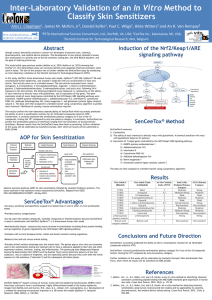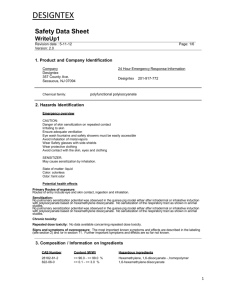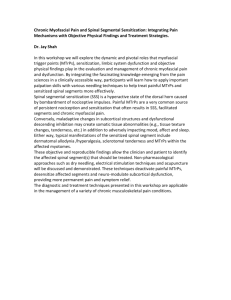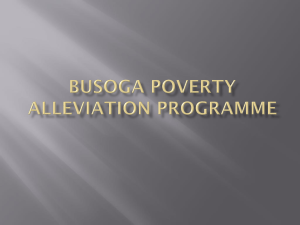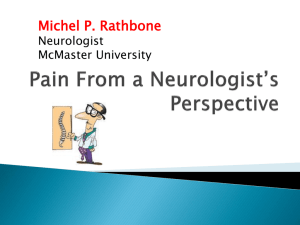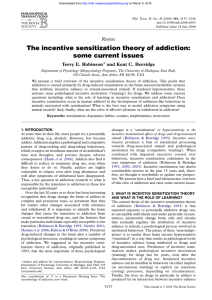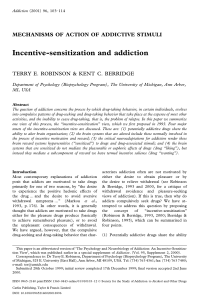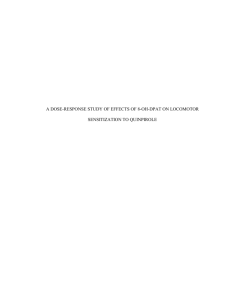UN/SCEGHS/19/INF
advertisement
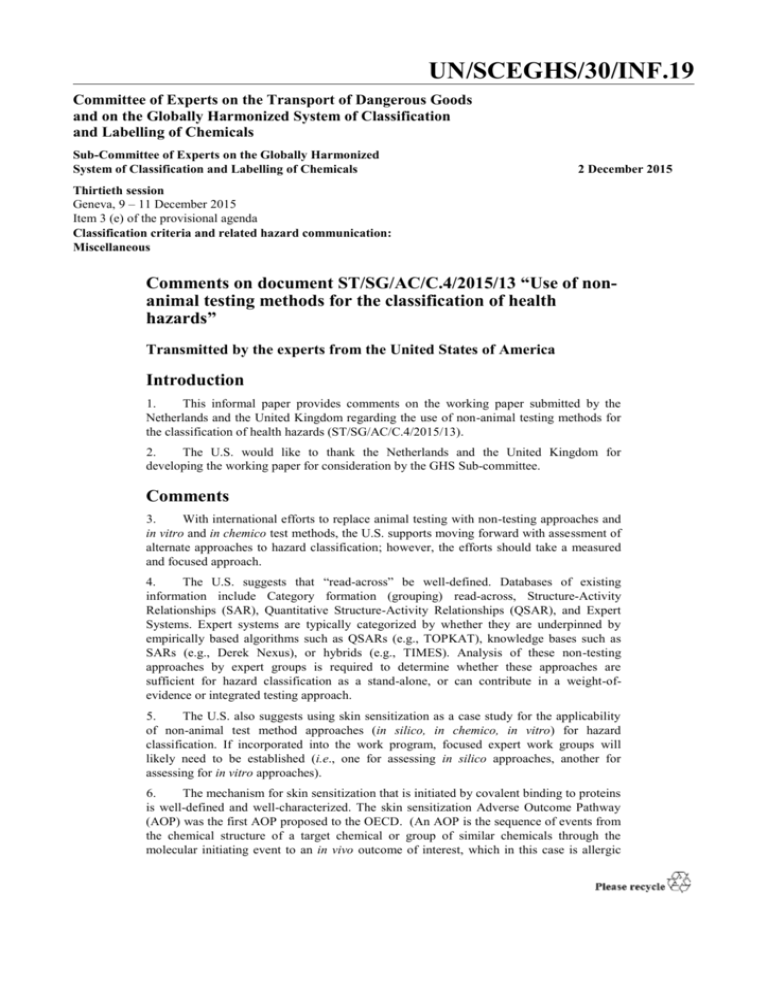
UN/SCEGHS/30/INF.19 Committee of Experts on the Transport of Dangerous Goods and on the Globally Harmonized System of Classification and Labelling of Chemicals Sub-Committee of Experts on the Globally Harmonized System of Classification and Labelling of Chemicals 2 December 2015 Thirtieth session Geneva, 9 – 11 December 2015 Item 3 (e) of the provisional agenda Classification criteria and related hazard communication: Miscellaneous Comments on document ST/SG/AC/C.4/2015/13 “Use of nonanimal testing methods for the classification of health hazards” Transmitted by the experts from the United States of America Introduction 1. This informal paper provides comments on the working paper submitted by the Netherlands and the United Kingdom regarding the use of non-animal testing methods for the classification of health hazards (ST/SG/AC/C.4/2015/13). 2. The U.S. would like to thank the Netherlands and the United Kingdom for developing the working paper for consideration by the GHS Sub-committee. Comments 3. With international efforts to replace animal testing with non-testing approaches and in vitro and in chemico test methods, the U.S. supports moving forward with assessment of alternate approaches to hazard classification; however, the efforts should take a measured and focused approach. 4. The U.S. suggests that “read-across” be well-defined. Databases of existing information include Category formation (grouping) read-across, Structure-Activity Relationships (SAR), Quantitative Structure-Activity Relationships (QSAR), and Expert Systems. Expert systems are typically categorized by whether they are underpinned by empirically based algorithms such as QSARs (e.g., TOPKAT), knowledge bases such as SARs (e.g., Derek Nexus), or hybrids (e.g., TIMES). Analysis of these non-testing approaches by expert groups is required to determine whether these approaches are sufficient for hazard classification as a stand-alone, or can contribute in a weight-ofevidence or integrated testing approach. 5. The U.S. also suggests using skin sensitization as a case study for the applicability of non-animal test method approaches (in silico, in chemico, in vitro) for hazard classification. If incorporated into the work program, focused expert work groups will likely need to be established (i.e., one for assessing in silico approaches, another for assessing for in vitro approaches). 6. The mechanism for skin sensitization that is initiated by covalent binding to proteins is well-defined and well-characterized. The skin sensitization Adverse Outcome Pathway (AOP) was the first AOP proposed to the OECD. (An AOP is the sequence of events from the chemical structure of a target chemical or group of similar chemicals through the molecular initiating event to an in vivo outcome of interest, which in this case is allergic UN/SCEGHS/30/INF.19 contact dermatitis). In silico, in chemico and in vitro test methods have been aligned with the key steps of the AOP. In vitro test methods (e.g., DPRA, KeratinoSens) have been validated for assessing skin sensitization potential, but with recommendations that the data from these test methods should always be considered in combination with other information in the context of integrated approaches such as Weight of Evidence (WoE) or Integrated Testing Strategies (ITS)1. 7. Integrated Approaches to Testing and Assessment (IATA) for skin sensitization based on the skin sensitization AOP have been developed. The OECD has published two guidance documents on skin sensitization IATAs: (1) Integrated Approaches to Testing and Assessment [IATA] for Skin Sensitization (OECD 2012), and (2) Guidance Document No. 168: The Adverse Outcome Pathway for Skin Sensitisation Initiated by Covalent Binding to Proteins: Part 1, Part 2 (OECD, No. 168, Part 1 and Part 2). In addition, a guidance document, prepared by an OECD Skin Sensitization Drafting Committee, is under review by the Skin Sensitization Hazard Assessment Task Force. The purpose of the guidance is to standardize the documentation of IATA and results, and it is not intended to evaluate or approve IATAs. However, the guidance document contains 12 case studies that could serve as a base for assessing the robustness of IATAs for predicting and classifying skin sensitization potential. These skin sensitization IATA case studies can provide a starting point for a flexible approach that still delivers consistent categorization. The U.S. suggests that the Sub-Committee consider ways to coordinate with these broad-based OECD expert groups. 8. While non-animal testing approaches have assessed the hazard potential for single substances, the utility of these approaches for assessing the hazard potential of mixtures needs to be demonstrated. 9. Future work may also consider the incorporation of Tox21 approaches. Relevant high-throughput screening assays, which may predict skin sensitizing activity, can be mapped to the skin sensitization AOP. 10. Alternate approaches may have applications not only for health hazard classification but also for environmental hazards. Proposal 11. Because of the extensive amount of analysis that will need to be performed and the breadth and depth of expertise necessary to assess the various read-across systems and the applicability of alternate test methods and/or integrated approaches, the U.S. proposes the establishment of a working group that will outline guiding principles/terms of reference for the proposed work. Once input is received and draft terms of reference developed, specific informal working groups should be created that address: • Evaluating the applicability of alternate in vitro and in chemico test method data for hazard classification. We suggest the working group initially focus on the hazard class of skin sensitization. • Issues on the use of read-across, including the identification of read-across methods that are appropriate for classification, and whether they may be used as a stand-alone classification method, or as part of a larger weight of evidence approach. ____________________ 1 ITS approaches integrate different types of data and information into a decision-making process. In addition to the information from individual assays, test batteries, and/or tiered test schemes, ITS may incorporate approaches such as weight-of-evidence and exposure/population data into a risk assessment for a substance 2

